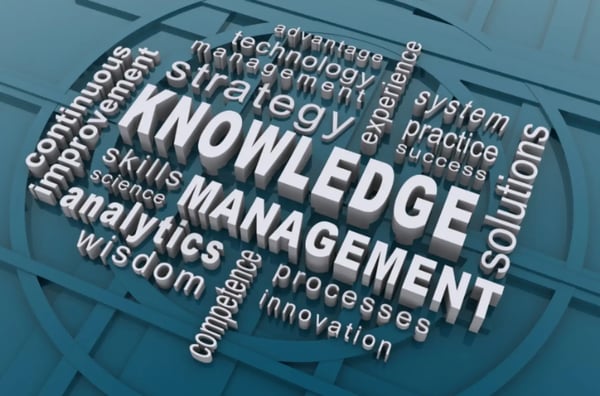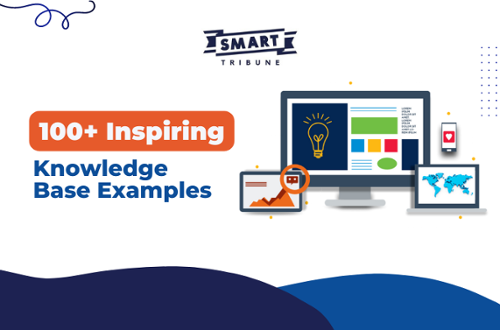
On FEBRUARY 20, 2023
How to Successfully Develop A Knowledge Management Strategy?
Running a company means that you have a lot in mind to worry about and one of the burgeoning headaches is to arm every employer with essential knowledge, skills and data to perform at their best. Understanding your concerns, Smart Tribune will be providing you with everything about knowledge management strategy (KM) to help you save time and effort in training, streamline the process of knowledge transfer and ultimately boost your organisation's productivity.
This article will equip you with:
- A knowledge management strategy definition,
- Steps to develop a winning knowledge management strategy,
- Importance of knowledge management strategy,
- Core components of knowledge management,
- Frequently asked questions about knowledge management strategy,
and so much more insights into knowledge management!
If you feel pumped already, let's dive in!

What is A Knowledge Management Strategy?
A knowledge management strategy is a plan for organising, capturing, sharing, and using an organisation's collective knowledge, information, and expertise to improve its performance and achieve its goals.
This can include practices such as capturing and sharing knowledge, creating a culture of knowledge sharing, leveraging technology, and continuously improving knowledge management practices.
The overall goal of a knowledge management strategy is to help organisations become more efficient, innovative, and competitive by leveraging the knowledge and expertise of their employees and other stakeholders.
Jeremy - Co-founder has dug deep into knowledge management and pointed out its importance. Check it out: An effective knowledge management system can create an enormous business impact.
How to Draw Up A Knowledge Management Strategy for Your Business?
Building a winning knowledge management strategy has never been an easy task. If you are attempting to streamline the knowledge transfer process for your business, here comes our detailed 8-step guide to bring an effective knowledge management strategy to real life.
Define your goals and objectives
Before jumping right into developing the strategy, you must determine the goals and objectives of your knowledge management to align other activities accordingly. Unambiguous objectives make it simpler for you to reach a decision on the next measures or steps to take to ensure the success of your strategy.
For example, if your goal is to train new staff, the content of your knowledge base should cover the company vision, positioning statement, culture, previous training sessions, and the like.

Different purposes require different approaches and content, therefore, in this nascent stage, you should dedicate more time to defining your goals clearly.
Assess your current knowledge management situation
The next step is to access and assess the current situation of knowledge management of all departments. Regularly, if you haven't created a knowledge management system, the knowledge will be kept internally and separately in each business unit. This may lead to informational or functional silos in your company as knowledge is scattered to the four winds.
You may need help from leaders or directors of every department to collect all knowledge and evaluate its compatibility and quality. The missing information can be added after in-depth research on your staff's requirements.
Identify your target audience
In this stage, your priority is to determine who will be impacted by your KM program and what their needs and expectations are.
Nothing can be more potent and handier than providing your staff with what they need most. Understanding your target audience enables you to figure out the suitable content in your knowledge management system.

Choose appropriate technology
Select the technology and tools that best support your KM goals and objectives and are aligned with your target audience's needs.
Define knowledge management processes
Determine the processes and procedures that will be used to capture, store, and distribute knowledge within your organization. This may include knowledge capture processes, knowledge sharing processes, and knowledge retention processes.
Establish a governance structure
Set up a governance structure to ensure the KM program is properly managed, monitored, and maintained. This may include a KM steering committee, a KM program manager, or a KM champion.
Establish metrics and measurement
Define how you will measure the success of your KM programmes, such as increased collaboration, reduced time-to-market, or improved customer satisfaction.
Implement and refine the strategy
Launch your KM programme and continually refine it based on feedback and results.
Why is A Knowledge Management Strategy Important?
A knowledge management strategy is worth its weight in gold as it greases the wheel of transferring knowledge and ensures the highest productivity for employees and even stakeholders. Let's check out how knowledge management strategy profits your business, your employees and your customers.
For Business
- Save time and money on training processes.
- Retain valuable resources for future utilization.
- Make the organization more professional.
For Employees
- Save time on finding information.
- Fill knowledge gaps in a short time period.
- Handle complex tasks with hands-on experience.
For Customers
- Be served promptly (as the sales representatives can find accurate information without a hitch)
- Enjoy the same customer service regardless of location or sales representatives.
What are the Main Types of Business Knowledge?
Explicit Knowledge
Explicit knowledge refers to knowledge that is codified and can be easily communicated, shared, and transferred through written or verbal communication. This type of knowledge is formalized and can be easily articulated and transferred to others.
Examples of explicit knowledge include written manuals, databases, procedures, policies, and guidelines. Explicit knowledge is often tangible and can be stored in a variety of forms, such as books, videos, databases, and other electronic media.

It can be acquired through formal education, training, and experience sharing.
Explicit knowledge is important because it allows individuals and organisations to store and share knowledge, which can lead to improved decision-making, increased innovation, and enhanced productivity.
However, explicit knowledge is only one part of the overall knowledge that individuals and organisations possess, and it is not sufficient on its own to create a complete picture of a person's or organisation's capabilities and expertise.
Implicit or tacit knowledge, which is more difficult to communicate and transfer, also plays a critical role in individual and organisational success.
Implicit Knowledge
Implicit knowledge refers to knowledge that is difficult to articulate or codify, and is often acquired through empiricism, observation, or practice. This type of knowledge is often rooted in personal beliefs, values, and previous experiences.
Simply put, implicit knowledge is skills and expertise you gained from the previous job, which you then developed and applied in the upcoming tasks you have in another company. This practice and experience supply you with the ability to recognise patterns or make intuitive decisions.
Implicit knowledge has a critical role to play in an individual's capability to effectively perform complex tasks, make decisions, and solve problems. Implicit knowledge can be difficult to replicate or transfer to others.

However, this type of knowledge can be shared through mentorship, coaching, and other forms of informal learning. Evidently, implicit knowledge is valuable in creating a culture of innovation and continuous learning within organisations.
Tacit Knowledge
Tacit knowledge is the information learned through experience that you can hardly recall and express. Tacit knowledge can’t be written down like implicit knowledge.
Impossible as it may seem, one of the effective ways to transfer tacit knowledge is first-hand mentoring. Staff in an organisation can exchange this type of information through interactive 1-on-1 continuous training sessions.

5 Core Components of Knowledge Management
In order to develop an efficient knowledge management strategy, business owners are supposed to deeply understand the core components. 5 well-known knowledge management components are people, process, technology, metrics and culture. Let's zoom in on each facet, its function, and how it contributes to your knowledge management strategy.
1. Human resources
It comes as no surprise that people play a vital role in a knowledge management strategy as they set the foundation for the whole process.
As a business owner, you will have to take into consideration 2 types of people in your knowledge management strategy. The first type is people who require knowledge and the second one is those who manage, store, and update knowledge.

Understanding what your employers need will help your organization effectively collect the necessary data without wasting time. You may answer the following questions to have the clearest ideas about your knowledge management strategy.
- Who are the users? What are their roles in the business, their departments, and their demographics?
- What knowledge do they need for a normal working day?
- How do they currently communicate and obtain the information they need?
- What are the hindrances when they collect the needed information?
- Are they willing to share knowledge? If not, why not?
By getting all of these pointed questions answered, you can easily find ways to satisfy your staff's requirements.
The other "people element" of your knowledge management strategy helping you meet your staff's needs can be anyone with expertise in your organisation, even you! 
As a matter of fact, everyone should contribute to the knowledge base as each one has his own strong suit and skillsets, which may substantially benefit others.
2. Knowledge creation and sharing processes
This involves defining the processes and methods for creating and sharing knowledge, such as mentoring programs or knowledge transfer meetings. Simultaneously, you should establish a flow of knowledge collecting and sharing.
After understanding what your staff expect from the knowledge base, you can check these prompts to sketch your ideal process:
- Where to store the knowledge?
- What to do after someone adds knowledge to the system?
- How to notify others about the freshly added content?
Creating a logical and clear process will save you, your staff and your organisation save an enormous amount of time as you can make sure that knowledge is well-documented and properly transferred.
3. Knowledge management tools and technologies
This involves selecting and implementing tools and technologies that support the creation, storage, and sharing of knowledge.

Technologies such as social media, intranets, and knowledge management systems make it easier for employees to share and access knowledge across the organisation. Quick and easy communication will eventually promote the sharing of knowledge.
Furthermore, databases, document management systems, and content management systems empower the capture and storage of organisational knowledge. This ensures that knowledge is not lost when employees leave the organisation or retire. Nor do employees have to worry about digital clutter accumulating on their personal devices.
Besides, video conferencing, instant messaging, and project management tools make it easier for employees to cooperate with each other, regardless of location or time zone. This leads to increased productivity, faster decision-making, and better problem-solving.
You can decide which technologies to go for based on your company's demands and budget.
This is when Smart Knowledge comes in handy. With the only Smart Dashboard, you can seamlessly integrate your knowledge base with popular customer service tools, such as Microsoft Teams, Salesforce, Messenger, Lines and so on. 
The flawless integrations enable your staff to access the knowledge with ease, which ensures their highest productivity and flexibility.
Smart Dashboard also supports your organisation to assign tasks to specific users and allocate information within one department or across the company. The personalized experience in the knowledge management system makes the content accessible to the right persons.
Smart Knowledge goes the extra mile in ensuring your staff are filled with needed information with the automatic notification of recently-added knowledge. The notification reminds your staff of the number of unprocessed questions, making your knowledge management strategy more effective. 
4. Knowledge metrics and evaluations
This involves defining metrics and methods for evaluating the effectiveness of the knowledge management strategy, such as knowledge usage, knowledge sharing, and business impact. These metrics and evaluations serve as a tactical primer to update the knowledge hub and improve its quality and usefulness to your organisation.
If you want to get to know more about some Knowledge Base use cases, feel free to read our article 100+ Inspiring Knowledge Base Examples.
5. Knowledge management culture
Last but not least, you should create a culture that values and supports knowledge management, such as encouraging collaboration, promoting knowledge sharing, and recognising and rewarding knowledge-sharing behaviours.
This culture will shape your staff's attitude toward the knowledge-enriching process. You can hold knowledge-sharing meetings weekly or monthly or on a regular basis to foster a habit of sharing. Some small gifts can be a great motivation and recognization for your employees. 
Developing a knowledge-sharing culture in your company ensures that no information will sink into oblivion.
FAQs about Knowledge Management Strategy
1. What is knowledge management?
Knowledge management refers to the implementation of collecting, storing, and sharing knowledge, especially, within a business. Knowledge management can boost business efficiency and productivity. Winning knowledge management strategies can be applied to a particular department or the whole company to make sure no vital information slips through.
2. What does a knowledge strategy allow you to do?
A knowledge strategy is a plan for how an organisation or individual will manage and leverage its knowledge assets to achieve its goals, Therefore, it can help identify and prioritise knowledge assets, create a culture of learning and knowledge sharing, sharp decision-making skills, foster innovation and creativity, enhance productivity and efficiency, and support growth and sustainability.
Final Thoughts - Aligning Knowledge Management With Business Strategy
Developing a spotless knowledge management strategy might be a challenging task, however, with the support from cutting-edge technology or inventions like Smart Knowledge, you can manage knowledge within your organisation much simpler.
Hope with our detailed guide and in-depth insights into knowledge management strategy, you will soon develop winning plans. Should you have any questions regarding the knowledge base, don't hesitate to contact us.



.png)



